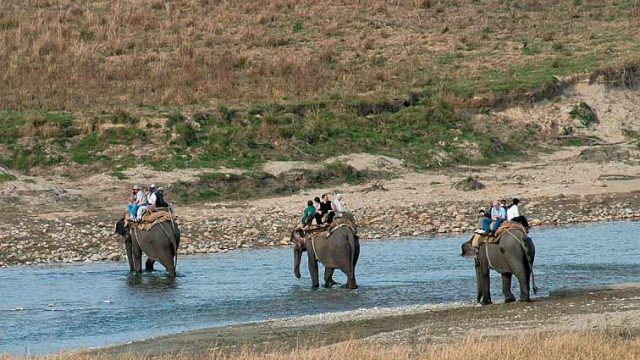Corbett, the oldest of India’s national parks, turned seventy-five this year. The authorities have planned a series of celebrations and events to mark the occasion: free safaris for about 1,200 schoolchildren as well as for groups of senior citizens from Ramnagar, workshops in the surrounding villages on man-animal conflict, photography contests, a state-wide quiz and a commemorative memoir. It is also a good time to take stock of the park’s situation on the conflict between conservation and eco-tourism—which need not be at loggerheads, but so frequently are.
Corbett National Park has faced many challenges over the years but is currently in the happy position of carrying about 200 tigers in its overall landscape. It has the highest density of tiger populations in the country: twenty tigers per hundred square kilometres. There are, however, immense stresses on the park and the most significant one is the extent of tourism that surrounds it. In 2010, a study commissioned by the Ministry of Tourism came out with a severe, damning report on Corbett and its environs, bringing notice to “the devastating impact of insensitive and unsustainable tourism on wildlife”. The park is surrounded by scores of private resorts that not only flout rules but together choke vital tiger and elephant corridors that connect Corbett with adjoining forests. It also went further to comment on the quality of tourism: “A majority of resorts around Corbett are promoting a different kind of tourism, which has little to do with a wilderness experience… More than three-fourths of the resorts offer DJ nights, rain dances, discos.” Corbett’s periphery is also plagued by encroachments, agriculture, human habitation as well as industries.
The park authorities and the Uttarakhand forest department point out that the majority of resorts are private property, built on revenue land and thus strictly outside the purview of the Tourism Ministry and the district administration. Of Dhikala, the forest rest house within the core area of the reserve which has come in for criticism, R.K. Mishra, Director, Corbett Tiger Reserve, says: “In fact, we have thirty-one rooms on offer here, which is not more than 120 persons at a time. It is not an insignificant number but not uncontrollably large either. We must necessarily find a balance between conservation and tourism.” However, the authorities plan to phase out the accommodation at Dhikala over a period of five to ten years—a move that falls in line with the standards laid down by the National Tiger Conservation Authority. Dr Shrikant Chandola, Chief Wildlife Warden, Uttarakhand, says, “This decision is part of the Forest Management Plan; eventually, we would like to see the core area completely free of overnight visitors. There will still be daytime tourism but not during nights—this, of course, relieves the area considerably because stay involves food, washing, etc.”
Already tiger reserves in India have made a start. In 2008, Tadoba closed down its rest house and canteen at Kolsa, shifting visitors to accommodation on the boundaries. Corbett, which has long shown the way in matters of conservation, should clean up its act as well.




